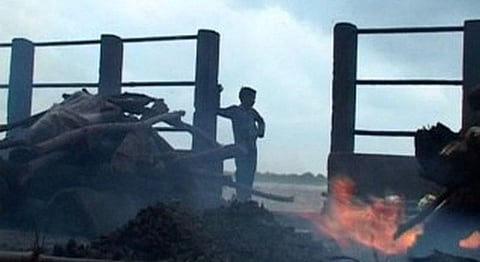
- HOMEGROWN WORLD
- #HGCREATORS
- #HGEXPLORE
- #HGVOICES
- #HGSHOP
- CAREERS
- ABOUT US
- CONTACT US

Last year the Government legitimised child labour by including a clause that has had activists up in arms since. By skirting their way around the law which forbids children below 14 years of age to work, the Child Labour Amendment Bill now allows children younger than this cut-off age to partake in family enterprises. It doesn’t take a genius to predict just how wide the scope for misuse is here, ensuring a loophole for those who employ children in their businesses for one, but perhaps more importantly—it puts children who are bound to their traditional family occupation at an even greater risk. How then can the children whose family businesses are ‘death’ hope to escape their own unlikely environments? Such childrens’ lives are exactly what documentary filmmaker Rajesh S Jala seeked to chronicle in his film ‘Children of the Pyre,’ and managed to accomplish with utmost poignancy.
Benaras, or Varanasi, means different things to different people - a place for salvation, a place of discrimination, death tourism for the uninitiated, and a playground for crematorium operators. When children become labourers in Manikarnika Ghats crematoriums, the dead are their playmates and the Ghats their play area.
Manikarnika sees hundreds of dead bodies everyday as a part of its daily tradition thanks to the idea that one attains ‘Moksh’ or freedom from the cycle of life after death in Kashi, Varanasi. And where there is supply, there is a demand—for people who are willing to do what’s necessary to ensure these dead bodies are ‘dealt with.’ Jala’s documentary, thus, follows the lives of seven boys who burn funeral pyres and are willing to do anything to make an extra buck. They are born in the lower caste ‘Dom’ families whose main source of income is lighting the funeral pyres of the dead; growing up surrounded by endless logs of wood on one side and the mighty river on the other. The boys ranging from 9 to 17 years of age at the time of shooting, go about their day waiting for people to die and stealing shrouds from pyres for later use, while watching dead human bodies and animals floating by in the Ganga - this is a regular day.
Jala’s film takes the medium of cinema to these extraordinary lives. It talks about what labour means to these boys and how they make us of the space given to them. Be it getting burned by the pyre, suffering injuries in the summer, or getting beaten for petty crimes, the ‘Children of the Pyre’ make do with the hand that has been dealt to them by the accident of birth.
During the celebrations for the God of the cremation ground, ‘Mahashamshan Devta’, everybody is witness to the dance of the ‘Nagar Vadhus.’ These women are the ‘wives of the village’ or prostitutes who pay their respects to the deity. The boys are no strangers to this either. Even when they perform the last rites of every dead person they are appointed, the living are the ones who experience the least mercy. In one of the scenes, a boy says how the upper caste folk don’t want even his shadow upon them. “They will mince me,” he admits matter-of-factly. Yet, everyday, these boys come out of the pyre like the mythological Prahlad from the Holika story, to survive yet another day.
The documentary itself doesn’t try comment on the moralities of their existence within society. Their story is of extreme lives being lived in extreme conditions where death is the only source of livelihood. “These boys are born in this environment. They don’t know anything else. With no funds for an education, they follow in the footsteps of their family. They become wise and mature beyond their years and being one with death day-in day-out changes them,” Jala tells us. In the film, they mock the dead bodies, smoke marijuana, have tussles with each other and pray for all the old people to die.
Winner of several international awards (Montreal and São Paulo Film Festivals), Jala met the boys when he was working on another shoot in Varanasi in 2006. He said that he spotted one of them snatching a shroud from a body. “I took three kinds of permissions to make the film – official permission, permission from the local touts, and most importantly, permission from the families of these kids,” he said. He added, “what worked in my favour was that I stayed very close to the cremation ghat and everybody could see the honesty in my approach.”
Ever since its release, ‘Children of the Pyre’ has received critical acclaim and accolades from audiences across the world, who are both shocked and awed by the contents of this film. So much so that a New York resident and his wife volunteered to pay for the education of these children. “Four of those children were at an age where they could be rehabilitated into a school. They are doing pretty well now in a good school in Benaras. The others were sent for vocational training but dropped out. Two of them are back to burning bodies and one does odd jobs,” Jala said.
He says the number of children working at the ghats has reduced according to his observation, but in the world’s most continuously inhabited city, the wheel of life and death keeps turning.
[Jala’s movie is available on Magic Lantern Foundation on DVD in India only. You can watch the trailer here]
